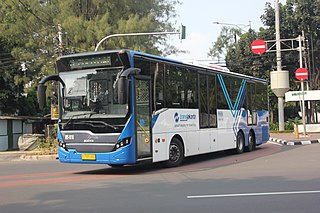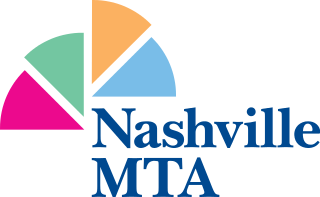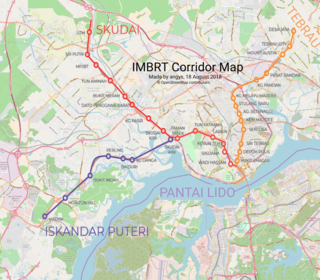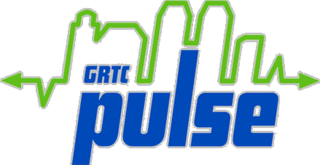Related Research Articles

Bus rapid transit (BRT), also referred to as a busway or transitway, is a bus-based public transport system designed to have much more capacity, reliability and other quality features than a conventional bus system. Typically, a BRT system includes roadways that are dedicated to buses, and gives priority to buses at intersections where buses may interact with other traffic; alongside design features to reduce delays caused by passengers boarding or leaving buses, or paying fares. BRT aims to combine the capacity and speed of a light rail transit (LRT) or mass rapid transit (MRT) system with the flexibility, lower cost and simplicity of a bus system.

Rail transport in Malaysia consists of heavy rail, light rapid transit (LRT), mass rapid transit(MRT), monorails, airport rail links and a funicular railway line. Heavy rail is mostly used for intercity services and freight transport as well as some urban public transport, while rapid transit rails are used for intracity urban public transport in the capital city of Kuala Lumpur and the surrounding Klang Valley region. There are two airport rail link systems linking Kuala Lumpur with the Kuala Lumpur International Airport (KLIA) and Sultan Abdul Aziz Shah Airport. The only-functioning monorail line in the country is also used for public transport in Kuala Lumpur, while the only funicular railway line is available in Penang.

The Nashville Metropolitan Transit Authority, which does business as WeGo Public Transit, is a public transportation agency based in Nashville, Tennessee. Consisting of city buses and paratransit, the system serves Nashville and Davidson County. In 2023, the system had a ridership of 7,634,900, or about 27,700 per weekday as of the fourth quarter of 2023. For 2023, the Nashville MTA expected to collect $5.2 million in fare revenue and to spend $99.3 million in operation. To make up most of the difference, MTA expected to collect subsidies from the city, state, and national governments.

The Iskandar Malaysia Bus Rapid Transit (IMBRT) is a proposed bus rapid transit system to be built in and around Iskandar Malaysia, Johor, Malaysia. It will consist of trunk, direct, and feeder bus rapid transit corridors.

Van Ness Bus Rapid Transit is a bus rapid transit (BRT) corridor on Van Ness Avenue in San Francisco, California, United States. The 1.96-mile (3.15 km) line, which runs between Mission Street and Lombard Street, has dedicated center bus lanes and nine stations. It was built as part of the $346 million Van Ness Improvement Project, which also included utility replacement and pedestrian safety features. Van Ness Bus Rapid Transit is used by several San Francisco Municipal Railway (Muni) lines including the 49 Van Ness–Mission, as well as three Golden Gate Transit routes.

The Cebu Bus Rapid Transit System is a mass transit system under construction in Cebu City, Philippines. It is expected to become the first operational bus rapid transit project in the Philippines. Only one line has been planned in detail so far, but scheme developers note the potential to develop a larger network comprising the adjacent cities of Lapu-Lapu, Mandaue, and Talisay, all of which, together with Cebu City, form part of the Cebu metropolitan area.

The BLAST network is a plan for a frequent rapid transit system in the city of Hamilton, Ontario, Canada. The system is planned to include five routes, with two light rail transit (LRT) lines, and three bus rapid transit (BRT) lines.

Bus rapid transit in New Jersey comprises limited-stop bus service, exclusive bus lanes (XBL) and bus bypass shoulders (BBS). Under the banner Next Generation Bus New Jersey Transit (NJT), the New Jersey Department of Transportation (NJDOT), and the metropolitan planning organizations of New Jersey (MPO) which recommend and authorize transportation projects are undertaking the creation of several additional bus rapid transit systems (BRT) in the state.

Bus rapid transit creep is a phenomenon where bus systems that fail to meet the requirements for being considered "true bus rapid transit" are designated as bus rapid transit regardless. These systems are often marketed as a fully realized bus rapid transit system, but end up being described as more of an improvement to regular bus service by proponents of the "BRT creep" term. The Institute for Transportation and Development Policy published several guidelines in an attempt to define what constitutes the term "true BRT", known as the BRT Standard, in an attempt to avert this phenomenon.

The BRT Sunway Line is a bus rapid transit (BRT) line that is part of the Klang Valley Integrated Transit System servicing the southeastern suburbs of Petaling Jaya, Malaysia. It is the world's first all-electric Bus Rapid Transit system.

Dar es Salaam Rapid Transit also known as UDART is a bus rapid transit system that began operations on 10 May 2016 in Dar es Salaam, Tanzania.

The GRTC Pulse is a bus rapid transit line in Richmond, Virginia, United States, operated by the Greater Richmond Transit Company. The line runs along Broad Street and Main Street in central Richmond, between The Shops at Willow Lawn and Rockett's Landing. It opened on June 24, 2018, and is the third bus rapid transit service to be constructed in Virginia. The Pulse is the first regional rapid transit system to serve Richmond since 1949. The Institute for Transportation and Development Policy (ITDP), under its BRT Standard, has given the Pulse corridor a Bronze ranking.

Albuquerque Rapid Transit (ART) is a bus rapid transit (BRT) system serving the Central Avenue corridor in Albuquerque, New Mexico, United States. There are two lines running between Tramway Boulevard, the Central and Unser Transit Center (CUTC), and the Uptown Transit Center (UTC). It was built in 2016–17 and began limited operation in November 2017, but was subsequently delayed for over two years due to problems with the stations and buses. After the original fleet of electric buses was replaced with diesel buses, the line began regular service on November 30, 2019.

The BRT Federal Line was a proposed bus rapid transit for Kuala Lumpur–Klang Corridors, and it has been identified in the KL BRT Report 2011 as one of the potential BRT Corridors in the Klang Valley region. The BRT project was planned to be operational by 2018, but is now shelved indefinitely. The government cited "redundancies with the LRT3 " as the reason for its decision to cancel the project.

Rainbow BRTS is a bus rapid transit system in the city of Pune. The system is operated by the Pune Mahanagar Parivahan Mahamandal Limited (PMPML). The infrastructure has been developed by the Pune Municipal Corporation & Pimpri Chinchwad Municipal Corporation, Pune. The project currently envisages 113 km of dedicated bus corridors along with buses, bus stations, terminals and intelligent transit management system.
The Kota Kinabalu Line is a proposed light rapid transit (LRT) system network in Kota Kinabalu, Malaysia, as one of the method to ease traffic congestion in the city. The proposal has been considered, and as reported in the government website, the project was in the ground breaking process under the Kota Kinabalu development plan. The current under construction project of the Aeropod rail station in Tanjung Aru also has made a provision for LRT in their plan.
The BRT Kota Kinabalu is a bus rapid transit (BRT) project to improve bus services in the city of Kota Kinabalu. An allocation of around MYR1 billion has been provided by the Malaysian government under the 2016 Malaysian Budget to implement the project. Currently, the project is under studies between the federal and state governments and it was predicted to be finished in 2020. It has also been lauded by the Prasarana Malaysia, the government-owned company specialise in bus and light metro development, the Chief Minister of Sabah, Musa Aman and various other politicians who said they have been waited for almost 10 years.

The Kuching Urban Transportation System (KUTS) is an under-construction Autonomous Rail Rapid Transit (ART) system network in Kuching, Malaysia. It is the first metro rail system to be built in the state of Sarawak which was touted as one of the methods to ease traffic congestion in the city of Kuching. The project is to be constructed using state funds provided by the Development Bank of Sarawak (DBOS). The proposed ART lines will connect Kuching to Samarahan and Serian as well as future lines to other parts of Greater Kuching. The Premier of Sarawak, Abang Abdul Rahman Johari Abang Openg had initially promised to build the first Kuching ART soon to avoid rising costs, with Chinese companies offering their expertise to collaborate in the construction.
Buses play a major role in the public transport of Malaysia, as well as seeing extensive private use. While rail transport has increased over the recent years due to road congestion, the same does not apply to buses, which have generally been used less in most of the area.
References
- ↑ Mohamad Raduan Kabit (October 2008). "Towards a Sustainable Transportation System for Kuching City" (PDF). Universiti Malaysia Perlis. Archived from the original (PDF) on 14 March 2016. Retrieved 14 March 2016.
- ↑ "Bus Rapid Transit system proposed for Kuching". The Borneo Post. 28 May 2011. Archived from the original on 14 March 2016. Retrieved 14 March 2016.
- ↑ "Construction of city's Bus Rapid Transit system to start next year". The Borneo Post. 2 September 2011. Archived from the original on 14 March 2016. Retrieved 14 March 2016.
- ↑ Yu Ji (16 November 2015). "More high-rises for Sarawak". The Star . Retrieved 14 March 2016.